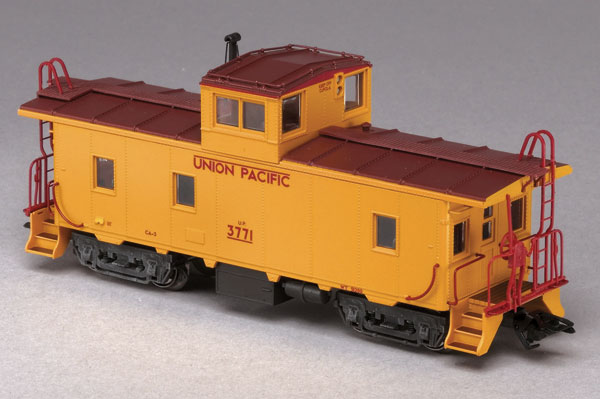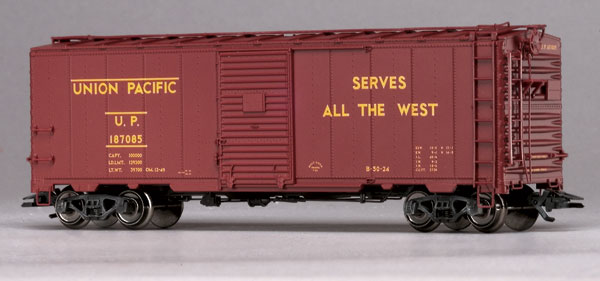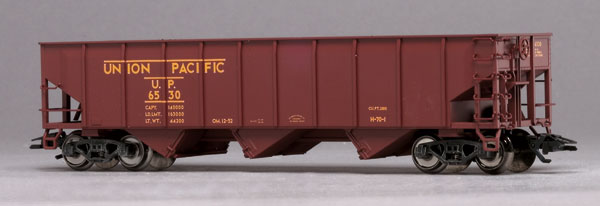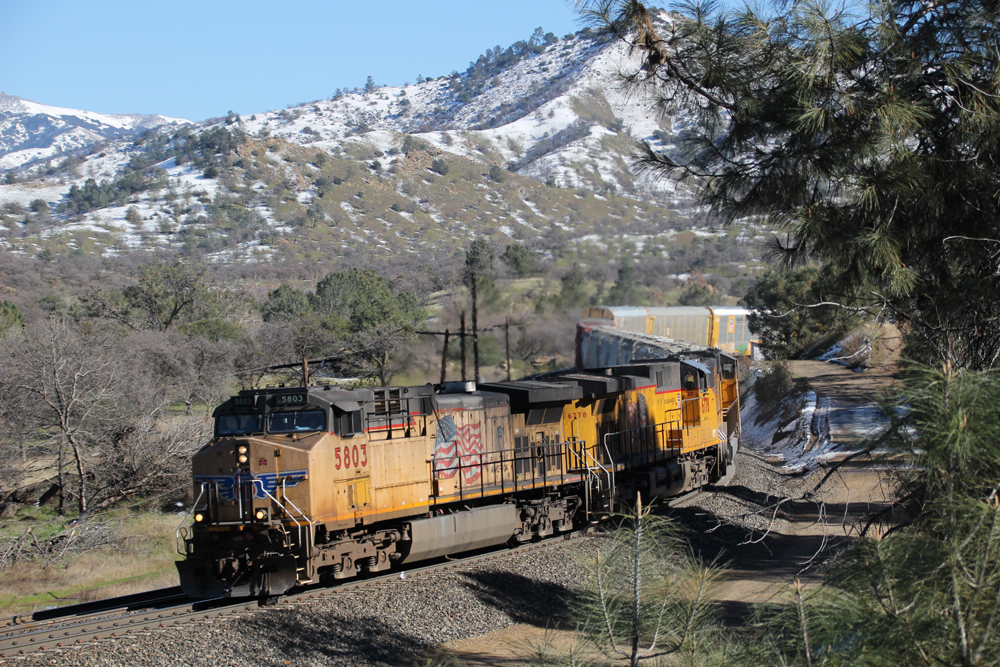CA-3 caboose
The 100 class CA-3 cabooses, numbered 3700-3799, were UP’s first steel cabooses. They were built in 1942 by Mt. Vernon Manufacturing and were originally painted oxide red with white lettering. However, in late 1947 and 1948, the cabooses were repainted in Armour Yellow with the red lettering scheme used on this model.
Märklin’s caboose has many fine details, particularly the metal grab irons, detailed interior, and wood beam Q-style trucks. Overall, the caboose is a good model, but unfortunately it has an incorrect roof. UP’s CA-3 cabooses were built with Murphy embossed steel roofs, not the flat roof used on the Märklin model. This will be corrected in the tooling for future runs.
The Märklin model also has electric marker lights and a red stripe on the cupola that UP added in modern times to cabooses used for through-train pool service. Only two CA-3s were upgraded to those standards. The Trix early version of the CA-3, shown on page 47, doesn’t have these marker lights.
Union Pacific built the class B-50-24 and B-50-27 40-foot boxcars at its Grand Island, Neb., Omaha, Neb., and Albina (Portland, Ore.) shops. There were 1,900 class B-50-24 boxcars built in 1939, and 1,500 class B-50-27 boxcars built in 1940. Some boxcars from these two classes remained in maintenance of way service into the 1980s.
The boxcars are decorated in several different lettering styles, including three with OWR&N and OSL reporting marks for the Oregon-Washington Railway & Navigation Co. and the Oregon Short Line, Union Pacific subsidiaries.
I was impressed with the detail on these boxcars. The molded plastic “metal” running boards and separately applied plastic grab irons and ladders are nice additions.
One detail that is incorrect, however, is the roof. Both prototype boxcar groups had Murphy stamped-steel roofs, but the models have a newer Pullman-Standard design which wasn’t introduced until the late 1940s. Märklin also plans to correct this on future runs.
H-70-1 hoppers
UP’s class H-70-1 triple hoppers were built by the Pressed Steel Car Co. of Mt. Vernon, Ill., in 1948 and 1949. Known as the PSC Payloader, these interesting 70-ton cars featured mostly welded construction, which helped minimize corrosion, particularly on the interior of the cars. These distinctive hoppers are unique in that they have offset sides with outside braces for increased cubic capacity.
The models closely match prototype dimensions and also feature separately applied metal grab irons, which look terrific in contrast to the plastic grab irons used on the boxcars.
Each hopper comes with a removable coal load. However, the car’s slope sheets, hoppers, and center sill don’t match the prototype drawings which appeared in the Simmons-Boardman 1949 Car Builder’s Cyclopedia.
Common details
All in all, Märklin did a fine job on these four cars. They feature a unique spring-loaded NEM draft gear system that telescopes out on curves and draws the cars close together on straight track. The Märklin cars come with European couplers and uninsulated wheelsets. (Similar cars are offered in the Trix line, with RP25 wheels and knuckle couplers.) The stock couplers can be easily replaced with Kadee nos. 17, 18, 19, or 20 magnetic knuckle couplers.
Price: boxcar ten-pack, $350
caboose, $39.95
hopper four-pack, $119.95
Manufacturer
Märklin Inc
P.O. Box 510559
New Berlin, WI 53151-0559
www.marklin.com
Description
Ready-to-run plastic-and-metal
Features
Coal load for hopper
Die-cast metal frame
NEM coupler pockets and non-insulated wheelsets
Optional metal RP25 wheelsets
Plastic body shell
Rigid-frame acetal plastic trucks with metal coil spring details
Sliding boxcar doors
Separately applied detail parts
Weight as compared to the NMRA’s recommended practice:
Boxcars are ¼ ounce light
Caboose is correct weight
















